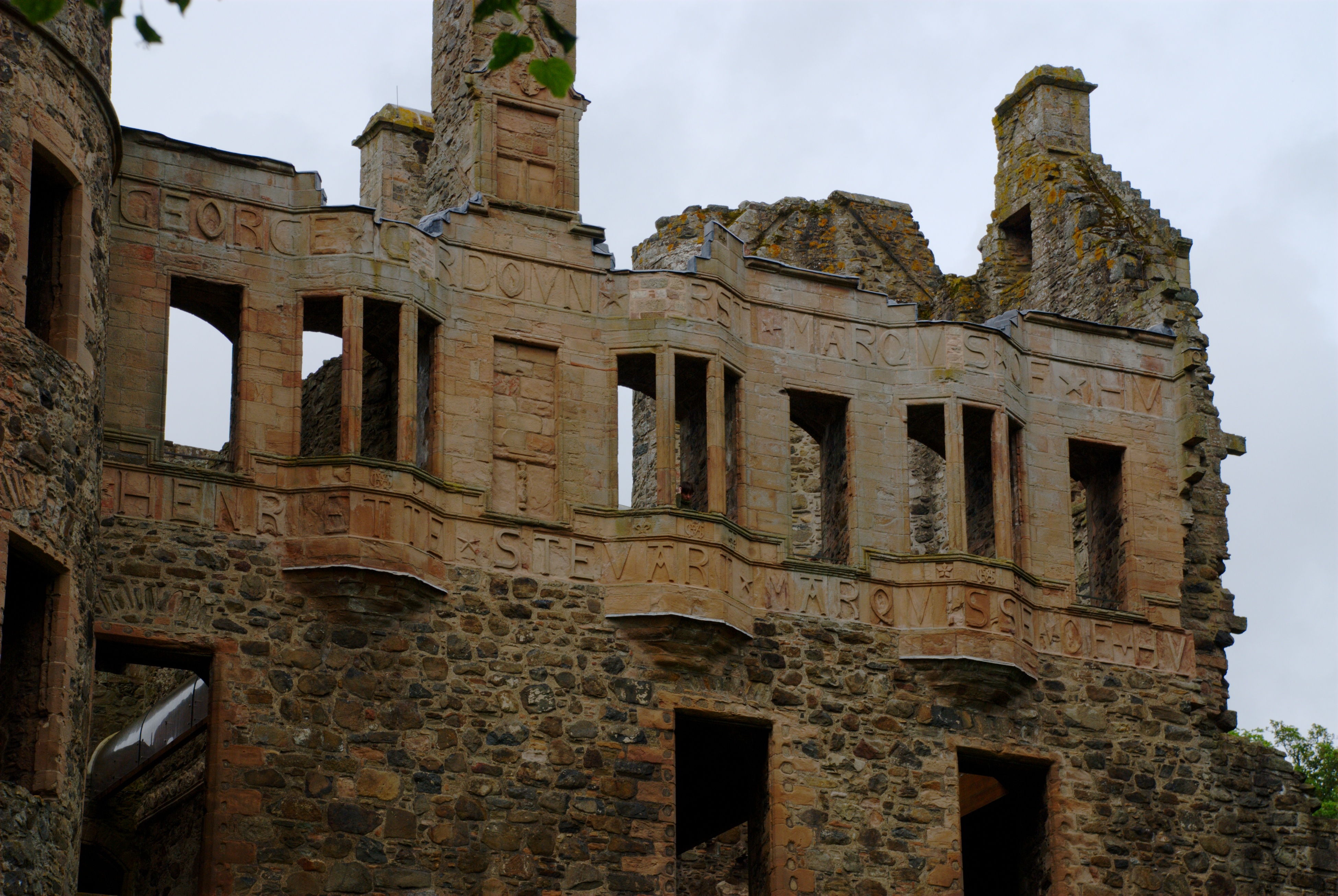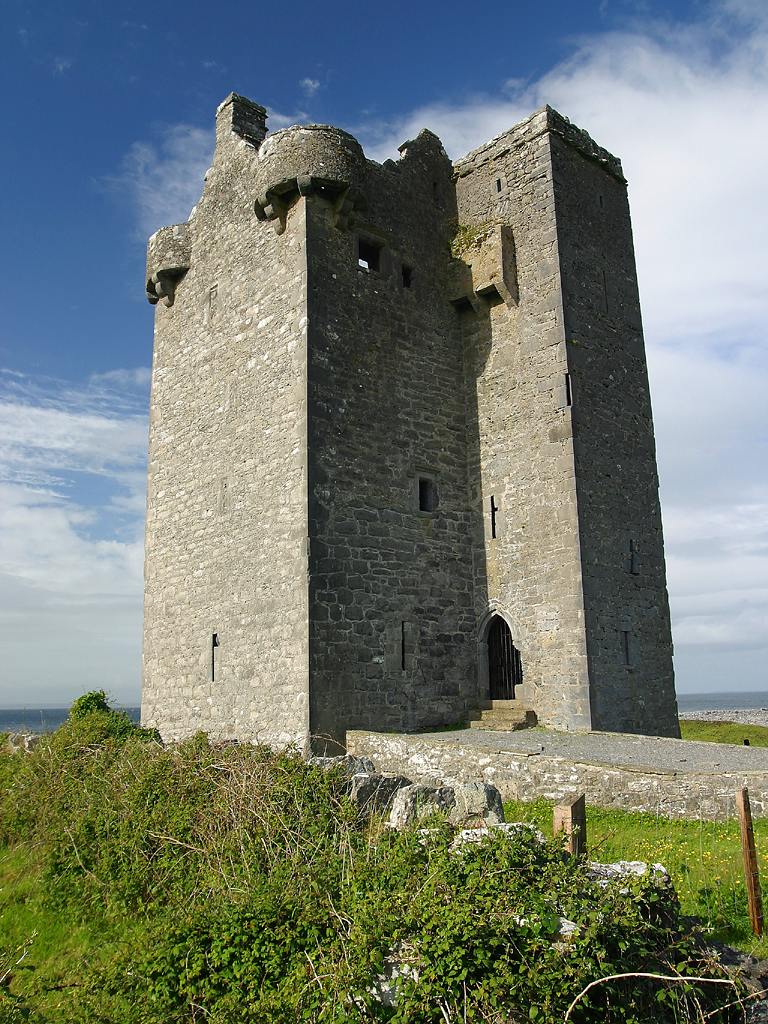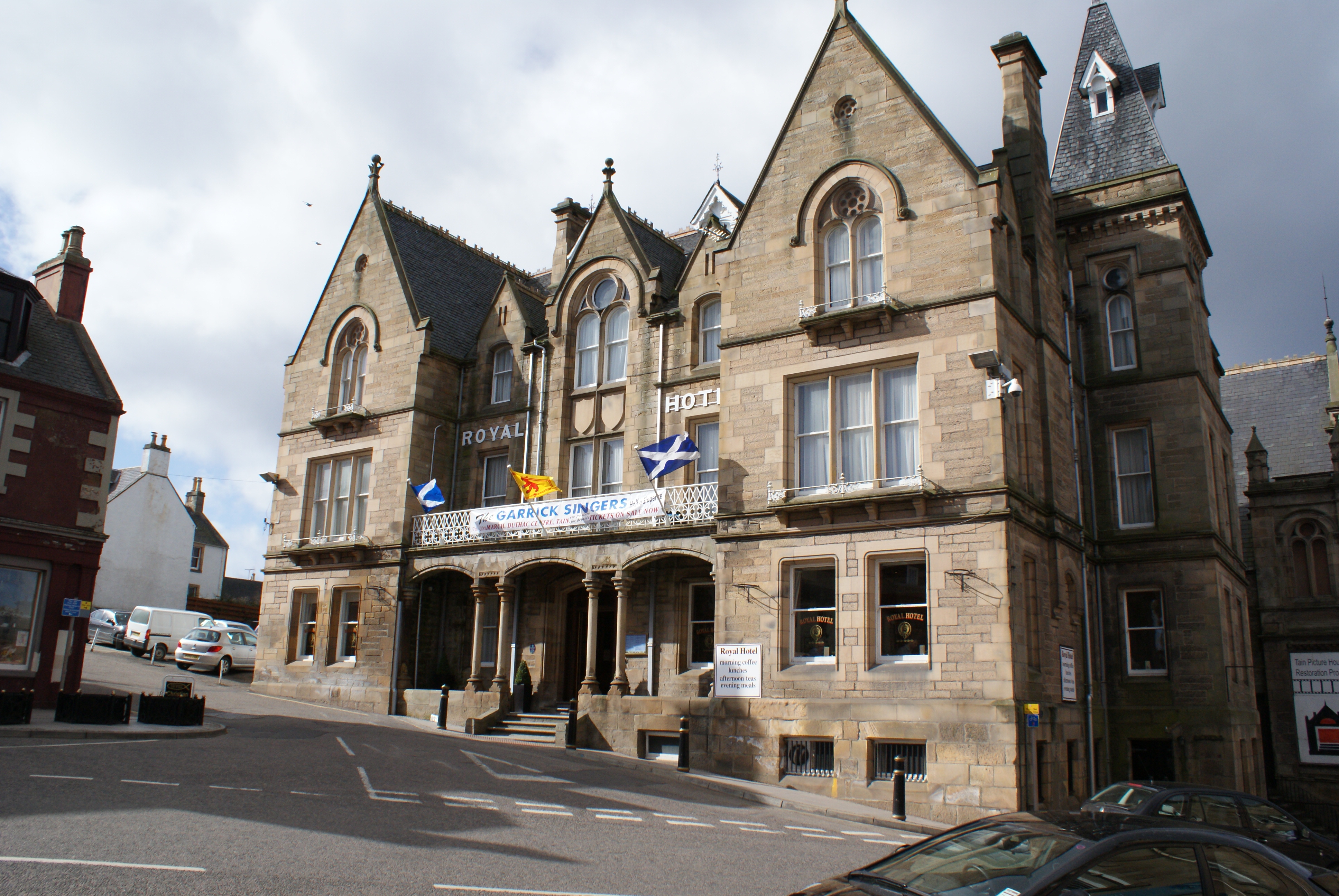|
Huntly Castle
Huntly Castle is a ruined castle north of Huntly in Aberdeenshire, Scotland, where the rivers Deveron and Bogie meet. It was the ancestral home of the chief of Clan Gordon, Earl of Huntly. There have been four castles built on the site that have been referred to as Huntly Castle, Strathbogie Castle or Peel of Strathbogie. Location Huntly Castle was built on the crossing of the rivers Deveron and Bogie, north of Huntly and roughly 40 miles from Aberdeen. The original wooden castle was built on a motte. The second castle, made of stone, was built on the northern end of the bailey. The third and modern castles were built to the east of the original, at the southern end of the estate. History The castle was originally built by Duncan II, Earl of Fife, on the Strathbogie estate sometime around 1180 and 1190. The castle became known as the Peel of Strathbogie. The Earl Duncan's third son, David, inherited the Strathbogie estate and later, through marriage, became earls of Atholl ar ... [...More Info...] [...Related Items...] OR: [Wikipedia] [Google] [Baidu] |
Donnchad II, Earl Of Fife
Donnchad II (died 1204), anglicized as Duncan II or Dunecan II, succeeded his father Duncan I as Earl of Fife in childhood. As a child of the previous mormaer, he was entitled to succeed his father through primogeniture, but not to lead his kin-group, Clann MacDuib. That probably fell to his cousin, Aed mac Gille Míchéil. Like previous mormaers of Fife, Duncan II was appointed Justiciar of Scotia (i.e. Scotland North of the Forth). Donnchad's minority also meant that Ferchar, Mormaer of Strathearn, took supreme place as head of the Gaelic nobility and guide for the boy-king Malcolm IV. The scholar Geoffrey Barrow suggests that it was during Duncan's tenure that ''Beinn MacDuibh'' took its names, i.e. when Duncan II acquired land in that area (Barrow, 1980, 86). Duncan, like other mormaers of Fife, kept in close association with the king. His name is recorded, among other places, in a charter granted to the priory on the Isle of May. Duncan's person was required to be ... [...More Info...] [...Related Items...] OR: [Wikipedia] [Google] [Baidu] |
Lady Catherine Gordon
Lady Catherine Gordon (–October 1537) was a Scottish noblewoman and the wife of Yorkist pretender Perkin Warbeck, who claimed he was Richard of Shrewsbury, Duke of York. After her imprisonment by King Henry VII of England, she became a favoured lady-in-waiting of his wife, Elizabeth of York. She had a total of four husbands, but there are no records of any surviving children. Family Lady Catherine was born in Scotland, the daughter of George Gordon, 2nd Earl of Huntly, by his third wife, Lady Elizabeth Hay.''The Scots Peerage, Founded on Wood's Edition of Sir Robert Douglas's Peerage of Scotland'', ed. James Balfour Paul, Vol. IV (Edinburgh: David Douglas, 1907), pp. 530-1 Some 19th-century writers had assumed she was a daughter of James I of Scotland, King James I's daughter Annabella of Scotland, Annabella, who had been the Earl of Huntly's first wife.Her mother was apparently not Annabella as some accounts have stated, as the Earl of Huntly divorced Annabella in 1471. Cath ... [...More Info...] [...Related Items...] OR: [Wikipedia] [Google] [Baidu] |
Mary, Queen Of Scots
Mary, Queen of Scots (8 December 1542 – 8 February 1587), also known as Mary Stuart or Mary I of Scotland, was Queen of Scotland from 14 December 1542 until her forced abdication in 1567. The only surviving legitimate child of James V of Scotland, Mary was six days old when her father died and she inherited the throne. During her childhood, Scotland was governed by regents, first by the heir to the throne, James Hamilton, Earl of Arran, and then by her mother, Mary of Guise. In 1548, she was betrothed to Francis, the Dauphin of France, and was sent to be brought up in France, where she would be safe from invading English forces during the Rough Wooing. Mary married Francis in 1558, becoming queen consort of France from his accession in 1559 until his death in December 1560. Widowed, Mary returned to Scotland in August 1561. Following the Scottish Reformation, the tense religious and political climate that Mary encountered on her return to Scotland was further agitated by pro ... [...More Info...] [...Related Items...] OR: [Wikipedia] [Google] [Baidu] |
Thomas Randolph (diplomat)
Thomas Randolph (1523–1590) was an English ambassador serving Elizabeth I of England. Most of his professional life he spent in Scotland at the courts of Mary, Queen of Scots, and her son James VI. While in Scotland, he was embroiled in marriage projects and several upheavals. In 1568-1569 he was sent on a special embassy to Russia, visiting the court of Ivan the Terrible. Randolph was also a Member of Parliament: for New Romney in 1558, Maidstone 1584, 1586 and 1589, Grantham 1559 and St Ives 1558 and 1572. Exile in France Thomas Randolph was born in 1523, the son of Avery Randolph of Badlesmere, Kent and Anne Gainsford (NOT the lady-in-waiting to Anne Boleyn). He entered Christ Church, Oxford at the time of its foundation, and graduated B.A. in October 1545, and B.C.L. in 1548. Shortly afterwards he became a public notary; and in 1549 he was made principal of Broadgates Hall (now Pembroke College), Oxford. He continued there until 1553, when the Protestant persecutions und ... [...More Info...] [...Related Items...] OR: [Wikipedia] [Google] [Baidu] |
Huntly Castle, Detail Of Front Inscriptions
Huntly ( gd, Srath Bhalgaidh or ''Hunndaidh'') is a town in Aberdeenshire, Scotland, formerly known as Milton of Strathbogie or simply Strathbogie. It had a population of 4,460 in 2004 and is the site of Huntly Castle. Its neighbouring settlements include Keith and Rothiemay. Both Huntly and the surrounding district of Gordon are named for a town and family that originated in the Border country. Huntly is the historic home of the Gordon Highlanders regiment which traditionally recruited throughout the North-East of Scotland. Huntly has a primary school (Gordon Primary) and a secondary school (The Gordon Schools) beside Huntly Castle. It is the home of the Deans bakers, which produce shortbread biscuits. In November 2007, Deans of Huntly opened their new visitor centre. Four of the owls from the local falconry centre starred in the Harry Potter films. History Settlement around the confluence of the Bogie and Deveron rivers dates back to the Neolithic period. Settlement remain ... [...More Info...] [...Related Items...] OR: [Wikipedia] [Google] [Baidu] |
L-plan Castle
An L-plan castle is a castle or tower house in the shape of an L, typically built from the 13th to the 17th century. This design is found quite frequently in Scotland, but is also seen in England, Ireland, Romania, Sardinia, and other locations. The evolution of its design was an expansion of the blockhouse or simple square tower from the Early Middle Ages. As building techniques improved, it became possible to construct a larger building footprint and a more complex shape than the simple blockhouse tower. A more compelling motivation for the L plan was the ability to defend the entrance door by providing covering fire from the adjacent walls. This stratagem was particularly driven by the advent of cannon used by attackers. It was common for the union of the two wings to have very thick wall construction to support a major defensive tower in the union area. For example, the stone walls of Muchalls Castle in Scotland are over 14 feet thick at the ground level. Built in the 13t ... [...More Info...] [...Related Items...] OR: [Wikipedia] [Google] [Baidu] |
William Mackintosh, 15th Of Mackintosh
William Mackintosh, 15th of Mackintosh (died 1550) was the chief of the Clan Mackintosh, a Scottish clan of the Scottish Highlands. He was also chief of the confederation of clans that was known as the Clan Chattan. Early life William Mackintosh, 15th of Mackintosh was the son of Lachlan Beg Mackintosh, 14th of Mackintosh and his wife Jean Gordon, daughter of Sir Alexander Gordon of Lochinver. His father, Lachlan Beg Mackintosh, had been murdered in 1524 when William was just three years old. Therefore, Hector Mackintosh, natural son of Ferquhard Mackintosh, 12th chief was chosen as his tutor and temporary leader of the clan. Hector's leadership was not universally acknowledged by the clan and as a result the Earl of Moray who was also a relation of William had him and his mother removed to his own house. He also arranged for William's mother to re-marry. The newly elected leader of the Clan Mackintosh and Clan Chattan, Hector, with the support of the clan saw the Earl's actions a ... [...More Info...] [...Related Items...] OR: [Wikipedia] [Google] [Baidu] |
Tain
Tain ( Gaelic: ''Baile Dhubhthaich'') is a royal burgh and parish in the County of Ross, in the Highlands of Scotland. Etymology The name derives from the nearby River Tain, the name of which comes from an Indo-European root meaning 'flow'. The Gaelic name, ''Baile Dubhthaich'', means 'Duthac's town', after a local saint also known as Duthus. History Tain was granted its first royal charter in 1066, making it Scotland's oldest royal burgh, commemorated in 1966 with the opening of the Rose Garden by Queen Elizabeth, the Queen Mother. The 1066 charter, granted by King Malcolm III, confirmed Tain as a sanctuary, where people could claim the protection of the church, and an immunity, in which resident merchants and traders were exempt from certain taxes. Little is known of earlier history although the town owed much of its importance to Duthac. He was an early Christian figure, perhaps 8th or 9th century, whose shrine had become so important by 1066 that it resulted in the royal ch ... [...More Info...] [...Related Items...] OR: [Wikipedia] [Google] [Baidu] |
Saint Duthac
Saint Duthac (or Duthus or Duthak) (1000–1065) is the patron saint of Tain in Scotland. According to the ''Aberdeen Breviary,'' Duthac was a native Scot. Tradition has it that Duthac was educated in Ireland and died in Tain. A chapel was built in his honour and a sanctuary established at Tain by the great Ferchar mac in tSagairt, first Earl or Mormaer of Ross in the thirteenth century, and was ministered by the Norbertine canons of Fearn Abbey. A century later, this sanctuary was notably breached by English supporters who captured Robert the Bruce's wife, daughter and sisters sheltering in the chapel. The chapel was burnt later in political violence between regional power groups, namely the Clan MacKay and the Clan Ross. The ruins of the chapel still exist as a centrepiece of St Duthus Old Burial Ground on the shores of the Dornoch Firth. Saint Duthac was greatly venerated in Scotland and his memory is still preserved in variations, in the names of places and organisatio ... [...More Info...] [...Related Items...] OR: [Wikipedia] [Google] [Baidu] |
Pilgrimage
A pilgrimage is a journey, often into an unknown or foreign place, where a person goes in search of new or expanded meaning about their self, others, nature, or a higher good, through the experience. It can lead to a personal transformation, after which the pilgrim returns to their daily life. Background Pilgrimages frequently involve a journey or search of moral or spiritual significance. Typically, it is a journey to a shrine or other location of importance to a person's beliefs and faith, although sometimes it can be a metaphorical journey into someone's own beliefs. Many religions attach spiritual importance to particular places: the place of birth or death of founders or saints, or to the place of their "calling" or spiritual awakening, or of their connection (visual or verbal) with the divine, to locations where miracles were performed or witnessed, or locations where a deity is said to live or be "housed", or any site that is seen to have special spiritual powers. S ... [...More Info...] [...Related Items...] OR: [Wikipedia] [Google] [Baidu] |
More Taubronar
The More Taubronar (died 1507) was a musician of African origin at the court of James IV of Scotland and his wife Margaret Tudor. His name is unknown. A "taubron" was a kind of drum, the word is related to the modern form "tabor". The word "More" or "Moryen" was used for people of African origin. Archival records credit the More Taubronar as the producer of a costumed dance or masque performed at the Scottish royal court. An African drummer in the archives Although his name has not been discovered, a few things are known of the drummer's career at the Scottish court through the royal treasurer's accounts. He was first noted in the accounts in December 1504. His fee for three months, a quarter, was £4-7s-6d. Scots. The "More taubronar" appeared at Linlithgow Palace, Stirling Castle and Falkland. James IV travelled with this drummer and four Italian minstrels to Dumfries, Eskdale and Peebles in September 1504. At Dumfries James IV gave 28 shillings to a musician called "Cloffie ... [...More Info...] [...Related Items...] OR: [Wikipedia] [Google] [Baidu] |









